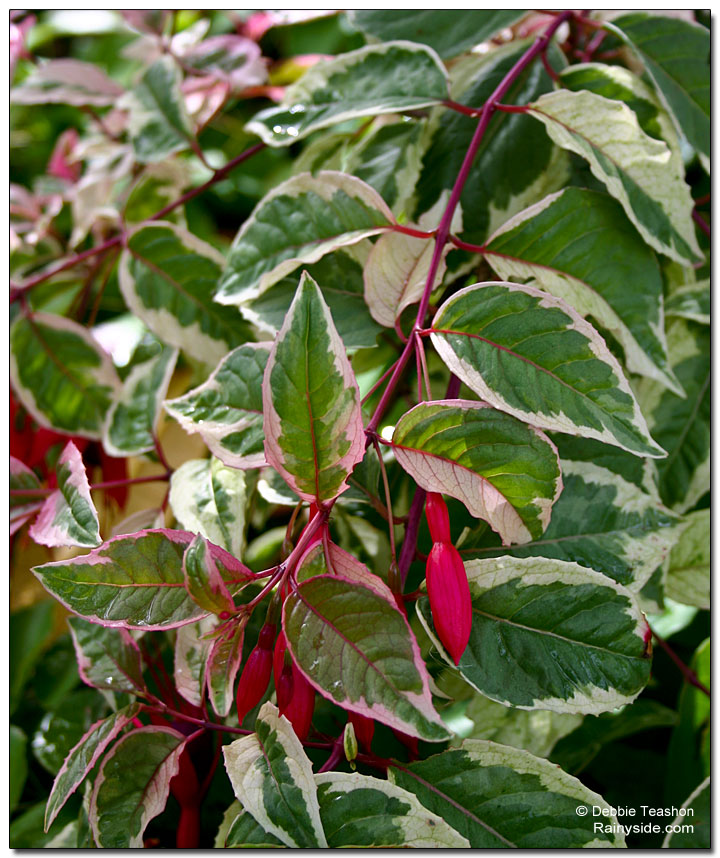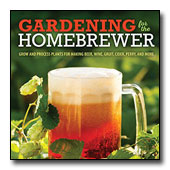Hardy Fuchsias in the Pacific Northwest

Fuchsia 'Swingtime'
My grandmother always grew luscious, large baskets of cascading fuchsias. I still remember admiring the red and white blossoms of what may have been Fuchsia 'Swingtime' in the containers that surrounded her porch. I loved watching the hummingbirds dart in and around them. It may be a family tradition to grow fuchsias; my mother grew them, my sister, and so do I. Perhaps someday my daughter will nurture them, too.
There were years I wanted to have fuchsia baskets hanging on my porch and could not afford the asking basket price. The year I discovered hardy fuchsias growing in someone's garden changed all that. Now, I always have one, whether it is in a basket hanging on my deck or planted in the ground.

Fuchsia 'Santa Claus'
There are many cultivar choices available. Even one that looks almost like F. 'Swingtime' but grows upright — F. 'Santa Claus'. Living in the Pacific Northwest, our climate puts few limits on options we can grow. Many hardy fuchsias do quite well here, thriving in our mild summers and wet winters. The only precaution I take is giving them well-drained, humus-rich soil and mulching them well in the fall by adding manure, compost, or leaf mold. In spring, the plants send out new growth, and by summer, they begin to bloom. Fuchsias continue to flower well into fall until the first frost. During mild winter years, some of them bloom throughout the dark days of winter.
Some years when we have an exceptionally frigid winter, fuchsias will die down to the ground. Before pruning in spring, wait until leaf buds swell, then prune out dead twigs, or prune down to the ground if winter knocked it entirely back. For established fuchsias, I fertilize in spring and sometimes in early summer. Younger fuchsias are fed monthly with a complete organic fertilizer.
With so many fuchsias to choose from and not enough garden to accommodate them all, here are a few of the favorites that I grow in my Pacific Northwest garden.
Fuchsia 'Tom West'

Fuchsia 'Tom West' is one of my favorites. With stunning foliage of cream, green, and pink along its red stems, the blossoms are almost an afterthought. The flower's purple corolla and red sepals tend to blend in with the foliage. I hear this variegated fuchsia grows well in hanging baskets. I imagine it looking spectacular confined to a container, although; I have not tried it. In my garden, it grows freely as a prostrate plant, cascading down over a rock wall.
Fuchsia magellanica var. molinae

The pale pink and lavender flowers of this cultivar make you believe it is a delicate plant. I am pleasantly surprised to see it reach upwards to eight feet tall and as wide, when I planned on it being much smaller, according to the books. This fuchsia cannot read and has surpassed its allotted space. Two vines reach into it, and the fuchsia seems no worse for the weight of a passionflower vine and clematis twining around its frame.
Fuchsia magellanica var. gracilis 'Aurea'

Add some hot salsa to your garden by adding this golden-leafed cultivar. This one takes the heat better than many fuchsias. I grow mine next to a large Phormium, and the pair compliments each other, while Hebe 'Paula' creeps in from the other side, adding her purple flowers into the mix. The scene transports me to the bright colors of more tropical climates.
Fuchsia Wish List
Fuchsia excorticata, a native of New Zealand, grows 10 feet tall, and what a marvel to walk under and look up into its unusual flowers. Its height, remarkable copper and brown colored bark that hangs in strips, gnarled trunks, and rare flowers with bright blue pollen make this perennial unique. Mine has yet to reach that height; I look forward to the scene I painted in my imagination to come to fruition. This subshrub is necessary for a fuchsia collector!
Another New Zealand native, Fuchsia procumbens, makes an exciting ground cover of unusual flowers with purple sepals and gold corolla. Even more extraordinary is that the flowers are upright with red stamens, blue pollen, and later pink, edible fruit. Perhaps this should be in my edible garden; recipes anyone? I will let you have the first taste test.
Nothing in the garden says its summer more than fuchsias and the hummingbirds who stake their claim to these hardy plants. There are many more fuchsias with photos and cultural advice for each one in the Plant Gallery and Growing Guide.
Debbie Teashon
Photographed in author's garden.

Gardening for the Homebrewer: Grow and Process Plants for Making Beer, Wine, Gruit, Cider, Perry, and More
By co-authors Debbie Teashon (Rainy Side Gardeners) and Wendy Tweton
Copyright Notice | Home | Search | Archives

